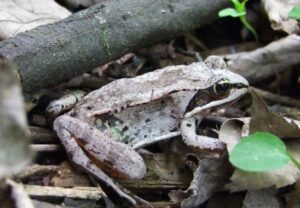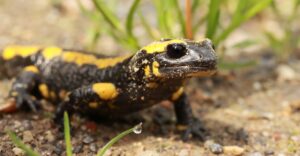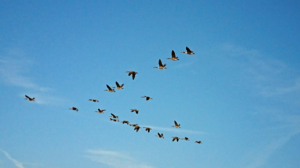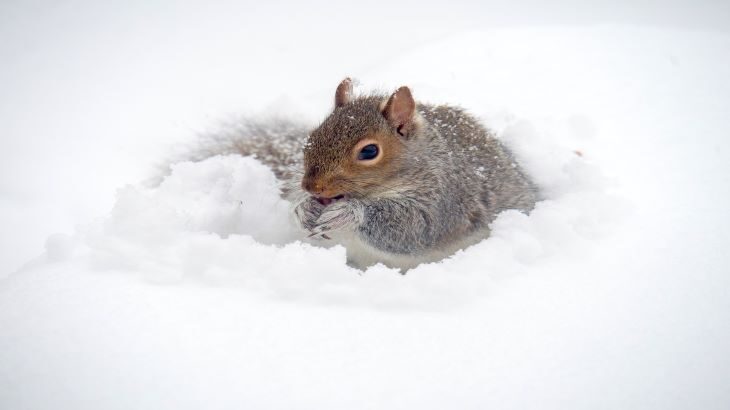By Nada Salem and Zahra Nassar, Chemistry co-editors
We’re almost there! We’ve survived another Canadian winter. It’s just about time to take off our scarves and hats and leave this winter season behind. This year was a tad colder than usual, with Vancouver (Canada’s characteristically warm haven) experiencing its lowest temperatures in 52 years. While Canadians often pride themselves on living in some of the coldest temperatures on Earth, the real troopers are the animals who survive the freezing temperatures out in the wild.
Canadian wildlife uses a variety of strategies to survive the changing of the seasons. Some hide, some hibernate, some freeze themselves alive (!), and some just leave. Broadly speaking, the mechanisms that animals use for winter survival depend on whether they are cold- or warm-blooded.
Cold-blooded animals
Ectothermic or cold-blooded animals depend on the environment to maintain their body temperature. They cannot regulate their body’s internal temperature, so it fluctuates with the temperature of their surroundings. These animals include reptiles, amphibians, most fish, and invertebrates. When colder seasons approach, most cold-blooded animals either freeze in place or hide underground or in the ground below the freezing interface.
Freezing in place
Freeze-tolerant amphibians essentially freeze themselves to protect their bodies during the winter. One such amphibian is the wood frog, a creature found in forests in every province and territory in Canada. These frogs can repeatedly freeze and thaw themselves over the winter season. When frozen, they tread a delicate line between life and death. Their hearts stop beating, their brains stop ticking, they stop breathing, and their organs stop functioning. They can survive in this dormant state for weeks or months at a time.

A camouflaged wood frog in Gatineau, Quebec. These cold-blooded animals are freeze-tolerant and spend the coldest days of the winter frozen solid. Image by W-van (CC 3.0).
Approximately 65% to 70% of the frog’s body water turns to ice during the frozen phase. If 70% of your water content turned to ice, your cells would dehydrate, eventually causing your organs to shrink as the ice accumulated. So how does an animal, whose blood freezes solid, thaw back to life and continue leaping and croaking as usual?
Cryoprotectants, or antifreeze, are key to freeze-tolerant animals’ survival. Cryoprotectants stabilize cell membranes and prevent ice from forming inside cells, which reduces the cellular damage caused by freezing. Cryoprotectants in wood frogs include glucose, glycerol, and urea. As air temperatures drop and the frog begins to freeze, its liver starts producing high concentrations of glucose. The glucose travels through the bloodstream, filling cells, organs, and tissues. By binding with water molecules, glucose prevents water from seeping out and dehydrating the cell. Specifically, interactions between glucose and water molecules—intermolecular forces—disrupt the lattice structure that forms as water solidifies into ice so that the cell walls remain hydrated intact.
In spring, air temperatures begin to rise. In response to this change, the frog’s organs start thawing. The first organ to reactivate is the liver, which has the highest concentration of glucose. Soon, its heart starts pumping, and the frog can breathe oxygen again.
Hiding underground

Fire salamanders hibernate underground in large groups. Image by Charly4u (CC0).
Not all cold-blooded animals can survive the harsh extreme of freezing themselves. Instead, some rely on finding warmer places to wait out the winter. Here, their body temperatures decrease but remain above the freezing point. Many go underground or burrow into the ground below the depth at which the ground freezes. Snakes and salamanders are examples of reptiles and amphibians that hide in deep underground burrows, well beneath the frost line, where the freezing temperatures can’t reach them. Snakes may also seek out dens belonging to other animals and huddle together to maintain their moisture levels. Many frogs and turtles burrow into the mud at the bottom of ponds and lakes and spend the winter there.
Warm-blood animals
Endothermic or warm-blooded animals regulate their body temperature, regardless of their environment. To do this, they need vast amounts of energy and have to eat — a lot. Endothermic animals include mammals and birds and, like cold-blooded animals, they have several strategies for surviving the winter, including hibernation and migration.
Hibernation
Like wood frogs, groundhogs drop their body temperatures to near freezing. This process slows their heartbeat and almost completely halts their metabolism. This process is called true hibernation, one of the three types of hibernation alongside brumation and torpor. In contrast to cold-blooded animals, endotherms need a steady energy source throughout hibernation to maintain their internal body temperature. This is why groundhogs, squirrels, bears and other mammals fatten up considerably before the winter, creating fat reserves they can burn through during hibernation.
Hibernation involves a chemical found in hibernating animals, dubbed “hibernation induction trigger” or HIT, which induces a drop in pulse and body temperature, and dissipates appetite when injected into non-hibernating animals like monkeys. The chemical composition of HIT suggests that it is similar to an opiate, the chemical in morphine and heroin that blocks pain and slows breathing. Animal hibernation is sparking questions about the potential human medical applications—think prolonged organ preservation during transplants.
Migration

Canadian geese flying in their well-recognized V-formation. This strategy reduces drag and saves energy during flight. Image by stephengg (CC BY-NC-ND 2.0).
And then, of course, there are Canada geese who travel south to avoid the cold altogether. A variety of animals migrate south before winter arrives, aided by a myriad of physiological changes to ensure a successful journey. Canada geese begin their autumn migration to the United States and Mexico in September. After spending several weeks eating for up to 12 hours at a time, the geese take to the skies, flying at speeds greater than 50 km/h. To help endure the long migration, thyroid hormones in the geese rise, increasing heart muscle mass, a process known as hypertrophy, and enabling faster metabolism. Many other migrating animals follow a similar process, building up body fuel and undergoing hypertrophy in preparation for a taxing migration.
Other animals migrate on a more localized scale. Caribou migrate across the land, while bighorn sheep move up and down mountains. Both of these species are searching for winter food sources. Caribou normally feed on the leaves of willows, sedges and tundra plants; in winter, they are forced to look for lichens and small shrubs. Caribou sometimes travel over 600 km in search of sustenance. On the other hand, bighorn sheep make a short altitudinal migration during the winter, moving from summer meadows up in the mountains to lower elevation shrubs.
Animals in the cold regions of North America have developed many strategies for dealing with seasonal temperature changes. More drastic and unpredictable seasonal fluctuations caused by climate change may lead to changes in the behaviours and patterns of these animals. Monitoring the behaviour of these animals may provide insights into what the future will look like for Canada’s wild animals and for the rest of us.
Feature image: Different species of squirrels have different strategies for surviving Canada’s cold winter. Some squirrels hibernate while others remain active and shelter in tree dens. Photo by LAWJR (CC0).




